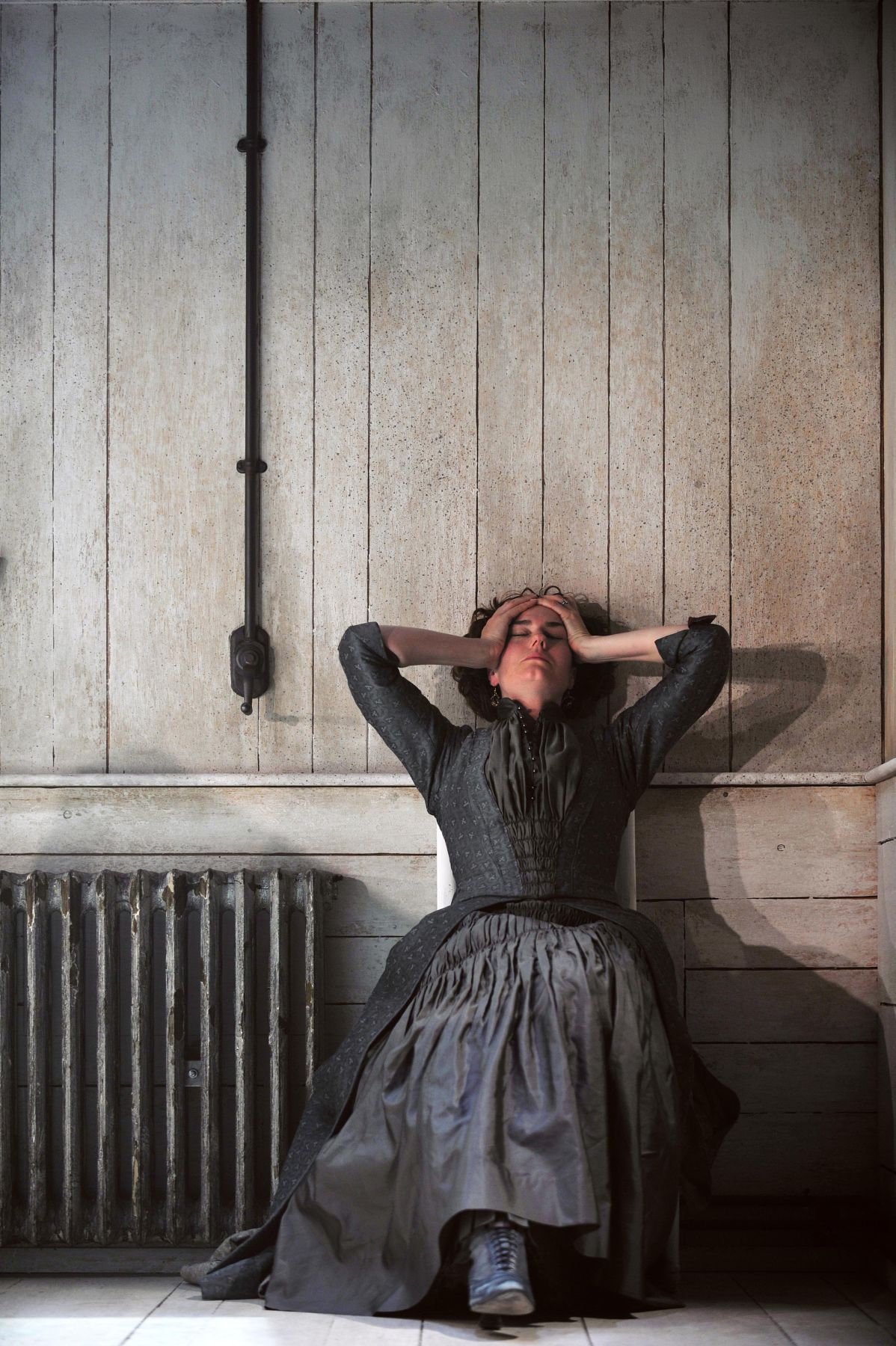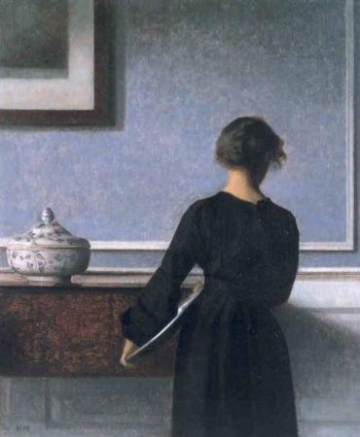Before seeing it performed a few days ago, I had never read August Strindberg’s 1888 play Creditors, but through the modern miracle of Google Books I was able to download in an instant a 1910 translation, prefaced with a warning from the translator that it “has both the excellencies and the extravagances peculiar to all revolutionary art.” Written in the same so-called Naturalist period that produced The Father and Miss Julie, Creditors has been far less frequently anthologized or produced, although Strindberg called it at the time of its composition “my favorite work.” (He also thought that all three of its characters were “sympathetic”—a view that has not been widely shared.)
On the page, especially in the diction of 1910, it seemed a challenging prospect for revival. In a one-act, three-character play pitting two men against the woman each blames for sapping their vital energies—a play consisting of nothing but relentless, nearly uninterrupted talk—Strindberg seemed to have managed a perfect encapsulation of his characteristic blending of antifeminist polemic and sexual paranoia. As a work of tortured self-revelation (full of direct allusions to the circumstances of his own first marriage, which had dissolved not long before the play was written) and, incidentally, as a document of late Victorian sexology at its murkiest, Creditors could hardly be surpassed, but it was hard to imagine contemporary actors playing it before a contemporary audience without eliciting squirms or giggles.
In Creditors Strindberg sets up a sort of minimalist hell. It is a play, he told an associate, for three characters and two chairs. At a resort hotel two men—the ailing artist Adolph and Gustav, an older man whose acquaintance he has just made—continue a conversation which has evidently been going on for days. Adolph seems almost pathetically grateful for the fresh burst of inspiration the older man has given him by advising him to abandon painting and take up sculpture instead. The talk turns to Adolph’s marriage and its discontents, with Gustav driving the discussion into ever more vulnerable areas as he forces his young friend to dissect his love for Tekla—a novelist whose star has risen just as Adolph’s career has foundered—and see what it really consists of. Within half an hour of stage time Gustav has managed to undermine Adolph’s faith in his art, his health, and his marriage alike, convincing him, all for Adolph’s own good of course, that Tekla—who years ago abandoned her first husband for Adolph after meeting the artist at this very hotel, and who is on her way to rejoin him—has selfishly robbed the painter of his creative strength by what might be called erotic vampirism, just as she had done, we are led to presume, with her first husband.
This initial duet is followed by two more of equal length: Adolph has it out with Tekla while Gustav (according to a prearranged scheme) eavesdrops from the adjacent room. Then, still following Gustav’s plan, Adolph—at the end of a lacerating scene that leaves little hope for the future of the marriage—leaves the stage to his friend while he in turn looks on in secret, to learn (what the audience has long since divined) that Gustav is the deserted husband exacting his revenge both on Tekla and the man who stole her from him. It is a play without half-measures, every moment freighted with maximum psychological violence; it must be played on its own terms or not at all. Might it not now be, for an audience, like entering a museum of the nineteenth century, to look at grotesque waxworks of those ancestors we are inclined to laugh at perhaps because we find them frightening, or perhaps again because we find their fears frightening?
As it turns out, Alan Rickman’s production, which was originally presented with great success at London’s Donmar Warehouse, has nothing of the quality of a historical reconstruction, even if it preserves impeccably the surfaces of the play’s original time and place. The effect is not to set us down in a period piece but to suggest that we are not all that far from the Sweden of 1888. The impersonal white-on-white hotel setting, with its two chaise lounges hinting at a convalescent ward and light leaking through the high narrow blinds, achieve perfectly the stripped-down, hard-edged look of the interiors depicted by Strindberg’s near contemporary, the Danish painter Wilhelm Hammershøi. The adaptation by the Scottish playwright David Greig indulges in no discernible updating or underscoring, merely paring away some of the dialogue without skirting any of the jabs and counter-jabs on which the play is strung.
At the outset, as Tom Burke (Adolph) and Owen Teale (Gustav) pick up what appears to be the civilized desultory conversation of two men on vacation, everything is spare and bright and dry. To read the text was to be overwhelmed by content, tone, texture: on the page the play seemed dark, dense, if not overwrought then in danger of seeming so. To see it played as it is at BAM is to be sublimely immersed in musical structure. The delicacy that emerges in performance is the other side of Strindberg, a delicacy of formal development counteracting and establishing a distance from the recurrent waves of brutal emotion and physical disgust that overwhelm his characters. Without that the plays would be what they very nearly are: the unmediated registering of the miseries and complaints of his own life, a life whose peculiar inner torments—rising at times to persecution mania and psychotic delusion—made it possible for the same man to be a founder of both naturalism and expressionism.
If director and cast proceed in every respect as if the play was a score to be interpreted as precisely as possible, they are doing no more than following the playwright’s own suggestion in the preface to Miss Julie:
I have avoided the symmetrical, mathematical artificiality of French dialogue and allowed my characters’ brains to work irregularly as they do in real life, where no subject is ever entirely exhausted before one mind discovers by chance in another mind a cog in which to engage. For that reason the dialogue also wanders, providing itself in the opening scenes with material that is later reworked, taken up, repeated, expanded, and developed, like the theme in a musical composition.
What is stunning about the production is its demonstration of how exactly Strindberg’s art could be realized; the intricate transformations that occur from moment to moment throughout the play’s length, and that culminate in murderous psychic debacle, unfold with cool clarity.
The play provides a brutal test for actors, to which Burke, Teale, and Anna Chancellor as Tekla are triumphantly equal. From line to line the dialogue slips from one gear to another while never straying from a pitch of extreme emotional tension. Anything that looks like a means of evasion or concealment, any attempt by the weaker to overthrow the stronger, inevitably leads toward a more naked and ugly acknowledgment of what cannot be evaded. In this context, a single failed line reading, a single misdirected glance would be enough to sink the entire play by allowing the audience to perceive the characters as absurd or unbelievable or completely repugnant.
Since the play is a set of variations on the themes of strength and weakness—with its central action the demonstration of how a stronger person may utterly destroy a weaker through a carefully orchestrated succession of subversive suggestions—perhaps it is not surprising that it seems so fragile at its core. Just as the characters are forced into knowledge of their own fragility, the play itself is an intricate machine kept afloat only by blind faith, without which it would collapse into a spectacle that no one would want to watch. It would become life, not theater. Only a writer who, like Strindberg, put so much of what he was on stage, making such literal use of his own crises and obsessions, could distinguish so absolutely between theater and life. That his plays are documents of his personal suffering has only an incidental relation to their beauty as theatrical constructs.
The immense accomplishment of this production is to make that beauty so fully perceptible. The direction and acting scrape away anything that might get in the way of Strindberg’s dramatic rhythms. There is little in the way of dire pauses or frozen postures. Most of the time things move and change too mercurially to permit tableau effects. The actors seem to get ahead of themselves, ahead of the play, and that turns out to be the play: predatory interruptions, slippery failures of connection, abrupt localized cave-ins, off-balance efforts to grab hold of something that changes form as soon as it is touched. The unease is not of shadows or silence but of bright exposing lights and of discourse incapable of being arrested, mood swings engendering further mood swings without even time to consider what just happened. It is a process of constant metamorphosis, continually articulating nuances of meltdown. No character is stable. To attempt to define oneself is already to become someone slightly different. From time to time language gives way to gesture—Tekla on the floor with her legs spread in sexual invitation, Adolph impotently brandishing his sculpting knife—as if in recognition of how utterly language has failed to rescue any of them from their predicament.
Advertisement
Creditors, directed by Alan Rickman, is playing at BAM through May 16.
An expanded version of this post will appear in a coming issue of The New York Review.




